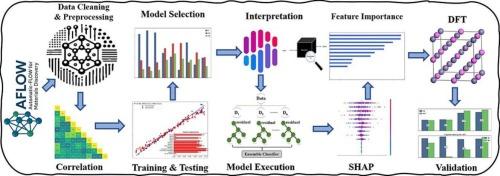新型全Heusler合金Mn2YAl (YFe, Sc, Ni, co)的设计:一种结合机器学习和DFT的磁性和电子性能研究
IF 4.6
3区 材料科学
Q2 MATERIALS SCIENCE, MULTIDISCIPLINARY
引用次数: 0
摘要
本研究提出了一种预测Full Heusler合金(FHAs)磁性和电子性能的新方法,该方法采用极端梯度增强(XGBoost),一种机器学习技术,以及密度泛函理论(DFT)计算。该模型采用特征工程、k-fold交叉验证和贝叶斯优化(BO)来精确预测从广泛的Heusler合金成分库中获得的材料性能。我们采用了严格的评估措施,结果在未知的测试集上表现优异,磁性的R2 = 0.90, MSE = 0.13, MAE = 0.21,电子性质的R2 = 0.87, MSE = 0.14, MAE = 0.26。与DFT相比,XGBoost模型产生了非常精确的预测,误差在- 12.4%到9.6%之间,可以忽略不计,从而提高了发现新材料的速度。这项工作展示了机器学习(ML)在材料科学中的应用,并促进了对具有磁性和自旋电子特性的HAs的进一步探索。本文章由计算机程序翻译,如有差异,请以英文原文为准。

Design of novel full Heusler alloys Mn2YAl (YFe, Sc, Ni, co): A combined machine learning and DFT study of magnetic and electronic properties
This study presents a novel approach for predicting the magnetic and electronic properties of Full Heusler alloys (FHAs) by employing eXtreme Gradient Boosting (XGBoost), a machine learning technique, alongside Density Functional Theory (DFT) calculations. The model employs feature engineering, k-fold cross-validation, and Bayesian optimization (BO) to precisely predict the material properties derived from an extensive library of Heusler alloy compositions. we employed rigorous assessment measures, resulting in a high performance on the unseen test set with R2 = 0.90, MSE = 0.13, and MAE = 0.21 for the magnetic and R2 = 0.87, MSE = 0.14, and MAE = 0.26 for the electronic properties. Compared to DFT, the XGBoost model produces very precise predictions with negligible error from −12.4 to 9.6 %, thus increasing the rate at which new materials are discovered. This work demonstrates the application of machine learning (ML) in materials science and facilitates further exploration of HAs, which are characterized by their magnetic and spintronic properties.
求助全文
通过发布文献求助,成功后即可免费获取论文全文。
去求助
来源期刊

Materials Science and Engineering: B
工程技术-材料科学:综合
CiteScore
5.60
自引率
2.80%
发文量
481
审稿时长
3.5 months
期刊介绍:
The journal provides an international medium for the publication of theoretical and experimental studies and reviews related to the electronic, electrochemical, ionic, magnetic, optical, and biosensing properties of solid state materials in bulk, thin film and particulate forms. Papers dealing with synthesis, processing, characterization, structure, physical properties and computational aspects of nano-crystalline, crystalline, amorphous and glassy forms of ceramics, semiconductors, layered insertion compounds, low-dimensional compounds and systems, fast-ion conductors, polymers and dielectrics are viewed as suitable for publication. Articles focused on nano-structured aspects of these advanced solid-state materials will also be considered suitable.
 求助内容:
求助内容: 应助结果提醒方式:
应助结果提醒方式:


